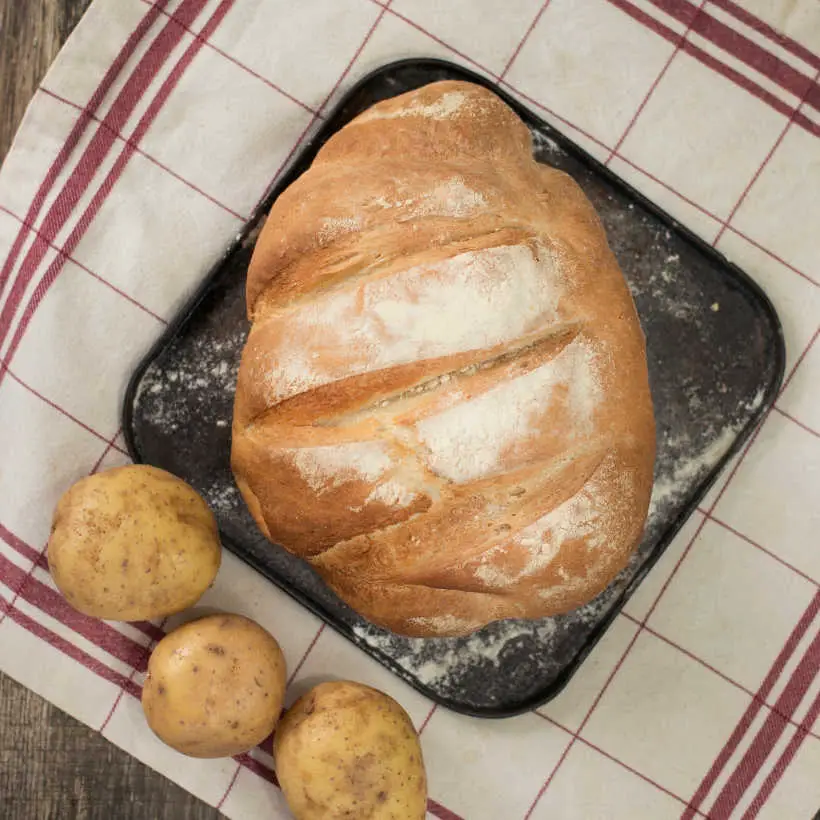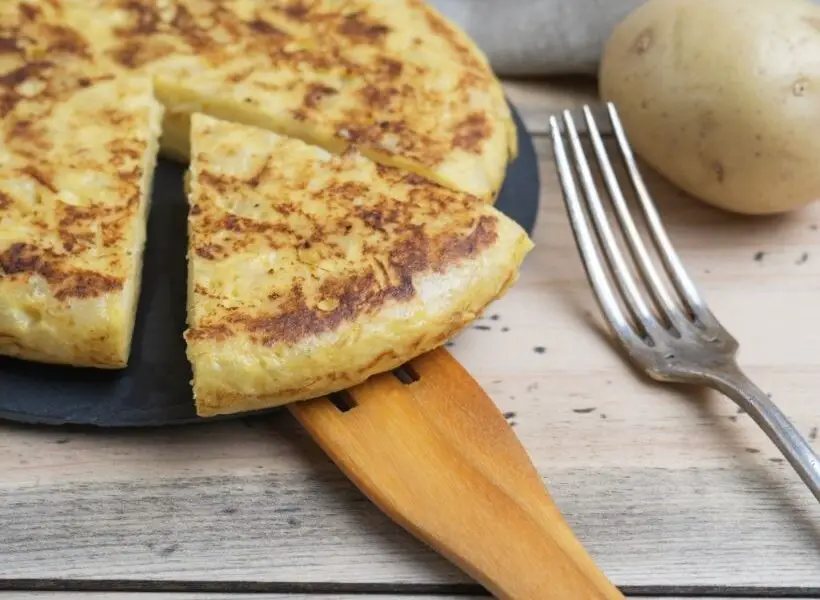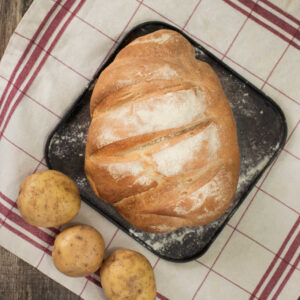If you want something a bit different to your ordinary white loaf bread, this is the recipe to try! The potatoes add lightness to the bread and the hint of nutmeg compliments the flavour beautifully. On the top of that you have the amazing flavour of cheddar cheese and chives add extra flavour and colour.
Potatoes were traditionally used to make the bread dough go further, as they were generally cheaper and more available than flour that had to be bought in from a local mill. We are talking a few hundred years back now, but I like the historic connection when I’m making this bread.
My top tips on making this potato bread
Don’t be tempted to add too much cheddar cheese – 2 tablespoons is enough to make this bread smell and taste like a cheese without making the dough too heavy, so that it wouldn’t hold it’s shape
Adjust the amount of salt based on what type of cheddar cheese you use – the stronger cheddar cheese you have the less salt you’ll probably need
Mature, strong cheddar cheese is the best to use – if you use too weak cheese, you’d need to add to much in and your bread dough won’t be able to absorb it.

Ingredients & Substitutions
Bread Flour
Always use strong or bread flour, because you will need the bread flour gluten to compensate for the gluten-free potato ‘flour – starch’. I’ve used white bread flour in this recipe as it compliments the cheddar cheese and chives flavour beautifully.
50% wholemeal bread flour and 50% white bread flour would work as well, just bear in mind that it will change the flavour of your bread.
If you have leftovers of different bread flours – say wholemeal, rye, white bread flour, you can mix them all together as long as you end up with 500 grams of flour mix at the end.
Ideally, you don’t want to add more than 100 grams of low gluten flour (like spelt or rye) or gluten free flours (buckweed, rice flour or any other gluten-free mixes). If you add to much gluten free flour the white bread flour gluten won’t be able to ‘hold’ your bread shape, but you can use up to a teaspoon of xanthan gum to compensate that.
Salt
I’ve used less salt in this recipe, than I normally do and that’s because the cheddar cheese is quite salty on it’s own. Salt is a personal preference, you can use more or use none – your bread will still rise as salt doesn’t have any impact on the dough, it’s just a flavour thing.
Water
The amount of water will depend on how dry your flour is and how starchy (and dry) your potato is. The best thing to do is to hold a little flour back, start mixing and kneading and then add more water if the dough needs it.
The potato starch will make the dough much lighter and it will feel stickier than usual, so use less water especially if you are not used to handling wet dough.
Nutmeg
Nutmeg is an amazing spice, that works well with potatoes and I always use it for mashed potatoes or baked au gratin potatoes. Nutmeg brings the potato flavour out even more, so it’s perfect to use in this recipe.
Saying that if you don’t have nutmeg in your spice rack, don’t worry and just leave it out.
Potato
The star of this recipe! The best time to make this bread recipe is when you have some leftover potatoes.
Alternatively, you can also make a quick ‘baked’ potato in the microwave, which is easier than to boil one potato.
Jab your potato with a fork several times and place on a paper kitchen paper towel in the microwave and cook for 5-6 min for small potato or 7 min for medium size. You can use any type of potato you have (it doesn’t have to be ‘baking’ type potato).
You can also use previously frozen potatoes as long as they have been cooked.

How to make this potato bread
Quantity, storage & baking in advance
This recipe makes about 750g bread – the best tin to use is 2lb bread tin or equivalent volume basket. You can also make about 12 -14 bread rolls from this recipe.
This Potato Bread freezes really well, so it’s well worth making a few loaves at a time. This basic recipe can easily be doubled and you should still be able to knead the dough easily. Then just divide the dough to fit your tins.
Basic method
Mix all dry ingredients together and add the mashed potato. Add the water and leave a little bit out, just in case. The potato can make the bread dough a little sticky and depending on how much water it already contains, you might need more or less water to add.
Kneed your potato bread for about 10 minutes until the dough becomes elastic and very smooth. Shape in a ball and place in oiled bowl, cover with tea towel. Leave it somewhere nice and warm until it doubles in size. This can take up to one hour.
If you prefer you can also leave to prove your bread in the fridge, which will take about 8 hrs. This is ideal if you don’t have the time to complete your bread baking in one day.
Knock back the bread dough, fold twice and shape by rolling in to a sausage to fit your tin or proving basket. Leave to double in size again.
Slashing the top of your bread
At this point, you can slash the top with bread knife to create the perfect artisan look. Slashing the top of your bread, not only adds an extra rustic look to your bread, but also serves a very practical purpose.
The cuts need to be only 1 cm deep and can be done by sharp knife, craft knife or specialist bread razor. Do this fairly quickly and do not allow the knife to drag the dough. Once in the oven, the cuts allow the bread to rise even more.
Creating steam in your oven
As you are putting your potato bread in the oven you might also like to create a bit of steam to help your bread to rise more in the oven. Create steam by placing baking tin at the bottom of your oven before you preheat the oven.
Have either ice cubes or boiling water ready and as soon as you place the bread in the oven, throw the ice cubes on the tray (or pour the water). Shut the door really quickly and be careful when you do this as steam is very hot!
The steam softens the top of the dough, which allows it to rise even more in the oven. You can also use flower water spray can and just mist the top of your bread as it goes in the oven.
Baking & knowing when your bread is done
Your oven should be initially as hot as you can make it (250 C) and after 10 mins reduce it to about 200 C. Bake for about 35 mins (in total) and check by tapping on the bottom of the bread, to see when it is ready.
Always check that the bread is baked through by tapping at the bottom of the bread. If it sounds hollow – it is done. If not, put the bread back into the oven (without the tin).
Cool on wire rack and enjoy with butter !
More bread recipes to try
- Dark Rye Bread with Molasses >>
- Large Soft Bread Rolls (Kentish Huffkins) >>
- Basic White Bread Loaf >>

Potato bread with cheddar cheese and chives
Ingredients
- 500 of strong white bread flour
- 1 ½ teaspoons of dried yeast
- 1 teaspoons of salt or according to taste
- 270 ml approx. of water
- 1/2 teaspoon ground nutmeg
- 2 tablespoons cheddar cheese grated
- 1 tablespoon chives
- 1 small potato – boiled and mashed left over potatoes are perfect for this
Instructions
- Mix all dry ingredients together and add the mashed potato.
- Add the water and leave a little bit out, just in case. The potato can make the bread dough a little sticky and depending on how much water it already contains, you might need more or less water to add.
- Kneed your potato bread for about 10 minutes until the dough becomes elastic and very smooth.
- Shape in a ball and place in oiled bowl, cover with tea towel. Leave it somewhere nice and warm until it doubles in size. This can take up to one hour.
- Knock back the bread dough, fold twice and shape by rolling in to a sausage to fit your tin or proving basket.
- Leave to double in size again. At this point, you can slash the top with bread knife to create the perfect artisan look.
- Your oven should be initially as hot as you can make it (250 C) and after 10 mins reduce it to about 200 C. Bake for about 35 mins (in total) and check by tapping on the bottom of the bread, to see when it is ready. Always check that the bread is baked through by tapping at the bottom of the bread. If it sounds hollow – it is done. If not, put the bread back into the oven (without the tin).
Notes
This recipe post was originally written on 12 November 2020 and last updated and tested on 25 March 2024








Leave a Reply